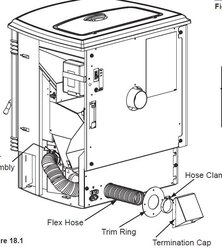With the many OAK fans here, the argument for having outside air piped to the stove while the fire's going are persuasive. Yet the fire's not always going, so from both condensation concerns and avoiding bringing in cold air when it's not needed concerns, it would be nice to have an OAK with a hatch of some sort that shut firmly when there's no flame to feed. Are there any on the market, or any designs that can be easily built at home?
A spring-loaded hatch relying on suction to open it probably wouldn't be a good enough design. If the spring is light enough to open with the moderate suction of a pellet stove, then it wouldn't shut the hatch that firmly, and a breeze from outside could open it. Something that combined suction with electromagnets to hold it open or closed might be sufficient. Or something that was purely mechanical with a small motor and the right sort of linkage into the stove's logic. Okay, I don't have a clear, good idea. Except I'm sure such a thing could be designed, and would expect the parts not to cost all that much. Since there's some real electrical and mechanical engineering talent here, assuming there's not already an automated OAK hatch on the market, what would you suggest?
I get it that if the stove is running constantly all winter, and the OAK disconnected in summer, there's little need for such a thing. This is more for those of us who often have stoves only cycling on for brief periods in shoulder seasons, or which are mostly off during sleeping hours because we prefer a chill room and blankets for sound sleep, or whose stoves are off for a week at a time mid-winter while we're off to grandmother's house - it would be convenient, energy saving, and perhaps prevent corrosion of the stove to have the OAK shut itself when the stove has no call for outside air just then.
A spring-loaded hatch relying on suction to open it probably wouldn't be a good enough design. If the spring is light enough to open with the moderate suction of a pellet stove, then it wouldn't shut the hatch that firmly, and a breeze from outside could open it. Something that combined suction with electromagnets to hold it open or closed might be sufficient. Or something that was purely mechanical with a small motor and the right sort of linkage into the stove's logic. Okay, I don't have a clear, good idea. Except I'm sure such a thing could be designed, and would expect the parts not to cost all that much. Since there's some real electrical and mechanical engineering talent here, assuming there's not already an automated OAK hatch on the market, what would you suggest?
I get it that if the stove is running constantly all winter, and the OAK disconnected in summer, there's little need for such a thing. This is more for those of us who often have stoves only cycling on for brief periods in shoulder seasons, or which are mostly off during sleeping hours because we prefer a chill room and blankets for sound sleep, or whose stoves are off for a week at a time mid-winter while we're off to grandmother's house - it would be convenient, energy saving, and perhaps prevent corrosion of the stove to have the OAK shut itself when the stove has no call for outside air just then.


